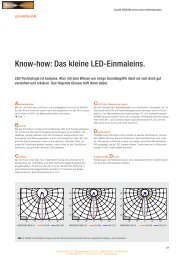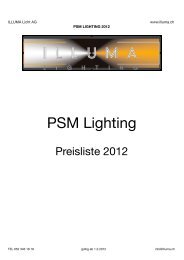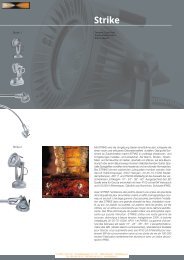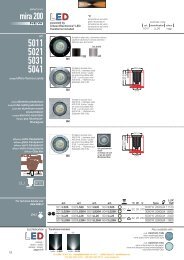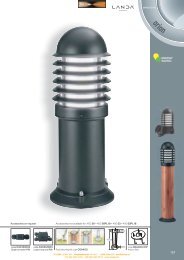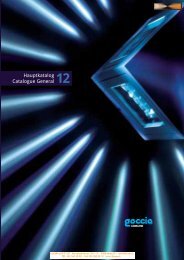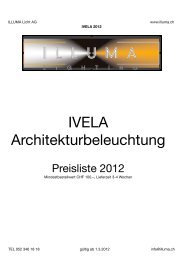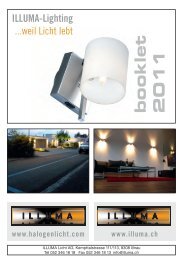Create successful ePaper yourself
Turn your PDF publications into a flip-book with our unique Google optimized e-Paper software.
direzione definita da un angolo<br />
solido unitario (I= dΦ/dω).<br />
L’unità di misura dell’intensità<br />
luminosa è la “candela” (cd).<br />
Lampada alogena<br />
Lampada a incandescenza in<br />
cui la presenza di alogeni nel<br />
gas di riempimento e il<br />
rivestimento in quarzo<br />
favoriscono il ciclo alogeno al<br />
tungsteno, portando i<br />
filamenti a temperature<br />
maggiori. Il risultato è una<br />
temperatura di colore più alta<br />
e una durata della lampada<br />
decisamente maggiore. Le<br />
lampade alogene vengono<br />
spesso utilizzate per creare<br />
effetti lluminosi brillanti.<br />
Lampade a ioduri metallici<br />
Lampade a scarica in gas ad<br />
attacco singolo o doppio che<br />
trovano impiego<br />
nell’industria, nelle aree<br />
pubbliche e nei negozi.<br />
Queste lampade uniscono un<br />
colore bianco naturale e una<br />
luce piacevole a un’alta<br />
intensità luminosa.<br />
Lampade a mercurio<br />
Lampade a scarica in gas che<br />
trovano impiego nell’industria<br />
e nelle grandi aree pubbliche.<br />
È possibile ottenere<br />
caratteristiche migliori della<br />
luce utilizzando lampade a<br />
ioduri metallici.<br />
Lampade a vapori di sodio<br />
Lampade a scarica in gas ad<br />
alta pressione caratterizzate<br />
da un colore tendente al<br />
giallo e da un rendimento<br />
particolarmente elevato.<br />
Led: Diodi a emissione<br />
luminosa<br />
Converte la corrente elettrica<br />
in luce attraverso il passaggio<br />
di scariche elettriche nel<br />
semiconduttore ottico (strato<br />
attivo).<br />
Luminanza (vedi dis. D)<br />
Esprime il concetto di<br />
percezione della quantità di<br />
energia luminosa irradiata da<br />
una sorgente luminosa non<br />
puntiforme: si definisce come<br />
il rapporto tra l’intensità<br />
luminosa emessa e la<br />
superficie emittente visibile<br />
dall’osservatore. La luminanza<br />
s’identifica con il simbolo: L.<br />
Il suo dimensionamento è<br />
definito dalla “candela per<br />
metro quadrato” (cd/m2).<br />
terminologie<br />
terms in use<br />
by a solid angle (I= dΦ/dω).<br />
Luminous intensity is<br />
measured in “candles”(cd).<br />
Halogen lamp<br />
It is an incandescent<br />
lamp, where the halogen<br />
compounds in the filling gas<br />
and the quartz<br />
coating improve the halogen<br />
tungsten cycle bringing the<br />
filaments to hotter<br />
temperatures. These lamps<br />
produce a higher color<br />
temperature and last much<br />
longer than standard lamps.<br />
They are often utilized to<br />
create bright lighting effects.<br />
Metal halide lamps<br />
These are discharge lamps,<br />
where an electric current<br />
passes through a gas. They<br />
can be a single or doubleended<br />
and are normally<br />
utilized in large public areas,<br />
production sites and shops.<br />
These lamps emit a natural<br />
white color and a pleasant<br />
light, granting a high light<br />
output, too.<br />
Mercury vapor lamps<br />
These are discharge lamps<br />
and produce light by utilizing<br />
vaporized mercury.<br />
Applications for this type<br />
of bulb are normally public<br />
areas, and industry.<br />
To obtain better lighting<br />
performance metal halide<br />
lamps should be used.<br />
Sodium vapor lamps<br />
These high pressure discharge<br />
lamps produce a warm yellow<br />
light and grant an efficient<br />
light output.<br />
Light emitting diodes.<br />
LED convert electrical current<br />
into light by the passage of<br />
electrical discharge in an optic<br />
semiconductor (active layer).<br />
Luminance (see graph D)<br />
It is the quantity of the<br />
luminous intensity per unit<br />
area projected in a given<br />
direction.<br />
It is defined as the ratio of<br />
the luminous intensity to the<br />
illuminated surface which can<br />
be seen by the human eye.<br />
Luminance is identified by<br />
the symbol: L Luminance<br />
is measured in candles per<br />
square meter (cd/m2).<br />
Lux:<br />
L’unità standard<br />
dell’illuminamento di una<br />
superficie illuminata.<br />
Un lux corrisponde a un lumen<br />
per metro quadrato (lm/m2).<br />
Reattore<br />
Dispositivo utilizzato nelle<br />
lampade a scarica in gas per<br />
stabilizzare la corrente nella<br />
scarica stessa.<br />
Resa cromatica<br />
La capacità di una sorgente<br />
luminosa di riprodurre i colori<br />
naturali, senza distorsioni<br />
della tonalità del colore, così<br />
come risultano se illuminati da<br />
un corpo nero (per esempio,<br />
luce naturale o lampade a<br />
incandescenza). L’indice di resa<br />
cromatica CRI ha un valore<br />
compreso tra 0 e 100.<br />
Rendimento<br />
Il fattore di rendimento di un<br />
apparecchio è il rapporto tra<br />
il flusso luminoso emesso e<br />
il flusso totale della lampada<br />
utilizzata. Essendo un rapporto<br />
tra due grandezze omogenee,<br />
è adimensionale ed espresso<br />
in termini di percentuale.<br />
È un parametro determinante<br />
per la definizione di un sistema<br />
d’illuminazione in termini di<br />
efficienza d’utilizzo dell’energia<br />
elettrica.<br />
Temperatura di colore<br />
Si definisce così un parametro<br />
qualitativo in ambito<br />
applicativo determinante per la<br />
scelta della lampada adeguata:<br />
in funzione della composizione<br />
spettrale delle radiazioni<br />
emesse si hanno rese del colore<br />
differenti tra loro.<br />
L’unità di misura della<br />
temperatura di colore è il<br />
“kelvin” (K).<br />
D<br />
Lux:<br />
It is a standard measuring<br />
unit for illuminance of an<br />
illuminated surface.<br />
One lux corresponds to one<br />
lumen per square meter (lm/<br />
m2).<br />
Ballast<br />
It is a device utilized in<br />
discharge lamps for stabilizing<br />
discharged current.<br />
Color rendering<br />
It is the capacity of how well<br />
a light source renders natural<br />
colors without altering tone<br />
if illuminated by a black body<br />
(for example, daylight or<br />
incandescent bulbs)<br />
The color rendering index CRI<br />
has a value between 0 and<br />
100.<br />
Efficiency<br />
It is the ratio of the emitted<br />
luminous flux to the radiant<br />
flux of the bulb utilized.<br />
As this is a ratio between<br />
two homogeneous sizes, it<br />
is dimensionless and it is<br />
expressed in a percentage. It<br />
is a fundamental parameter<br />
for designing a lighting system<br />
in terms of an efficient use of<br />
electricity.<br />
Color temperature<br />
It can be defined as a<br />
qualitative parameter for<br />
defining the right type of lamp<br />
for a specific application: it is<br />
based on the color spectrum<br />
of the radiations emitted and<br />
the different colors produced.<br />
Color temperature is measured<br />
in “kelvin” (K).<br />
293



